Jakarta, 31 October 2025 – Climate Policy Initiative (CPI) launched the updated Indonesia Power Sector Finance Flow Dashboard, revealing that Indonesia’s power sector received a total of USD 38.02 billion or an annual average of USD 7.6 billion in investments during 2019-2023, less than half of the USD 19.4 billion required annually to meet the country’s 2030 climate targets. The latest data highlights opportunities to strategically direct more financing toward renewable energy and supporting infrastructure that can drive Indonesia’s low-carbon future.
Developed through rigorous data triangulation that consolidates various official datasets, this interactive Dashboard provides a reliable, comprehensive, up-to-date, and open-access view of Indonesia’s power sector investment landscape. It maps financing sources, sectoral allocations, and thematic uses, covering both renewable energy (RE) and fossil fuel (FF) investment flows to support government, industry, and financial stakeholders in making informed policy decisions and exploring appropriate RE investment opportunities.
Key takeaways from the 2019–2023 investment trends analysis include:
- The annual average of RE investments was at USD 1.79 billion, far below the USD 9.1 billion annual investment needed to align with Indonesia’s Enhanced NDC targets. While Indonesia has just launched its Second NDC, with an estimated total investment needs of USD 472.6 billion through 2035, there was no reported sectoral allocation for RE specifically. RE investments were also considerably lower than the annual average of reported fossil fuel investments at USD 2.55 billion.
- Investments in RE were mainly from domestic sources (55%) and concentrated in baseload RE power plants (geothermal and hydropower). Private finance dominated (60%), while public finance contributed the rest. Variable RE finance (solar and wind) experienced an overall growth from USD 0.03 billion in 2019 to USD 0.68 billion in 2023.
- Private financial institutions (FI) were the dominant drivers of power sector financing, contributing 73.72% of total reported investments. Most of this went to FF (59.25%). Notable international private financiers funding FF projects include China (USD 2.48 billion) and South Korea (USD 1.52 billion)
- An estimated USD 10.63 billion (more than 50%) of coal-fired power plant (CFPP) investments from 2019 – 2023 were not reported, highlighting significant data gaps and therefore likely larger actual coal investment. This is because not all data on Captive CFPP has been officially reported.
- Highlighting the overall efficiency of PLN’s energy portfolio, operational costs per unit of production of FF power plants are high, including diesel (IDR 2,541 per kWh), gas (IDR 1,450 per kWh), and coal (IDR 603 per kWh). In contrast, operational costs per unit of production of PLN’s RE plants are relatively lower, including geothermal (IDR 977 per kWh), hydro (IDR 110 per kWh), and solar (IDR 3,111 per kWh).
- The operational costs of CFPP (IDR 603 per kWh) compared to solar power plants (IDR 3,111 per kWh) as recorded in PLN’s reports differ from those observed in the global market (global benchmarking). This discrepancy is influenced by several factors, including the Domestic Market Obligation (DMO) policy and the capacity factor of installed solar power plants:
- Simulation of operational cost per unit of production for CFPP without the DMO subsidy policy shows a much higher cost, reaching IDR 1,211 per kWh.
- PLN has the opportunity to reduce the operational cost per unit of solar power production to IDR 731 per kWh by increasing the capacity factor of its solar power plants from 4% currently to the average 16% of solar power plants in Southeast Asia.
“Indonesia’s energy transition is moving forward, but it will depend not only on how much investment we mobilize, but where and how it flows,” remarked Tiza Mafira, Director of CPI Indonesia. “The data shows progress, but still with clear imbalance. Fossil fuel retained the largest share of investment, more than twice that of renewable energy. With transparent and granular data like that in our Dashboard, policymakers and financiers can better target investments to accelerate Indonesia’s transition to a low-carbon future,” Tiza concluded.
Explore the Dashboard here: https://www.climatepolicyinitiative.org/dataviz/indonesia-power-sector-finance-dashboard/

